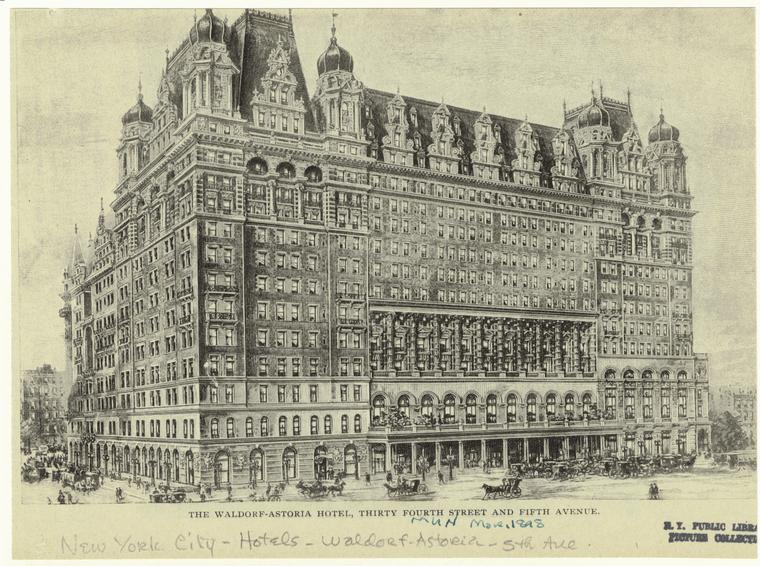The Waldorf-Astoria Hotel
The Waldorf-Astoria Hotel is synonymous with luxurious accommodations. Guests expect excellence in surroundings, room service, food and entertainment. One hundred years ago, white glove service was also expected by guests at the first Waldorf-Astoria's Hotel located on 5th Avenue and 33rd Street.
The Waldorf-Astoria had a tumultuous history. The Waldorf-Astoria hotel was originally built as two separate hotels. After tearing down his father's mansion, William Waldorf Astor built the Waldorf Hotel at the corner of 5th Avenue and 33rd Street. This former mansion stood next to his aunt Caroline Astor's brownstone.
Astor fought with Caroline Webster Schermerhorn Astor over who would be known as "the Mrs. Astor." William believed that his wife, Mary Dahlgren Paul should enjoy that designation. Caroline Astor, a formidable woman, already had this distinction as the gate-keeper of high society.
To retaliate against his aunt, William Waldorf Astor built the Waldorf Hotel. It opened 1893 towering over his aunt's mansion. Instead of a genteel family, Caroline Astor had to contend with strangers coming and going.
William, for reasons of his own, moved to England. Not to be outdone by his cousin, Caroline's son John Jacob Astor IV persuaded his mother to move out. She relocated to the Upper East Side leaving the brownstone to be demolished. In its place, John Jacob Astor built the Astoria Hotel.
In anticipation of the Astoria Hotel, The New York Times wrote the following:
"The style of the architecture will be that of French Renaissance, and the building itself, Mr. Hardenberg [architect] says, will be something of a copy of the Grand Hotel in Paris on a smaller scale... In this court will be a fountain about which will be placed luxurious resting places on which male guests may lounge and smoke their after dinner cigars. An orchestra, in all probability, will assist in the soothing effects of good digestions... One of the radical innovations in the management of the new hotel will be the establishment at the main entrance of a concierge —a plan usual in France—and this individual will guard the entrance. It will be his duty to prevent the admission of persons who have no right to enter or whose presence would obviously be unpleasant. The concierge will likewise be a convenience to people who come in late at night." The New York Times, May 29, 1890.
As an Engineer. A First. Miss Parker's Success in a Novel Profession
The Astoria Hotel hired a woman civil engineer, Marian S. Parker. Parker, at twenty years old, was the only woman engineer in the United States. During her interview with the New York Times, she discussed her family background.
Parker stated that her interest in mathematics led her to become a civil engineer. When the Times questioned her about obtaining an education, Parker remarked that she did not have a problem at all. She went to Ann Arbor the same school as her father. All the classes at the university were co-educational. The New York Times, January 4, 1897
At the same time that the Astoria Hotel was being built another building received notice in the press. This building would eventually reside on 5th Avenue and 42nd Street.
"Plans for the Library: Architects Asked to Submit Drawings for the New Public Building which will cost $1,700,000. Will be Two Competitions. Details of the Number of Rooms and Arrangement Required by the Committee-Care for the Convenience of the Public". The New York Times, May 24, 1897
The Astoria Hotel opens and becomes the Waldorf-Astoria Hotel
A truce was brokered between the Astors by George C. Boldt. As the proprietor and lessee, Boldt connected the Waldorf and the Astoria hotels through a colonnade know as "Peacock Alley." Peacock Alley would become the place to be seen and to watch the well-heeled dressed in their finery.
The Waldorf-Astoria Hotel operated for another twenty-years, finally closing its doors in 1929. This site was designated for the Empire State Building. Several years later, the Waldorf-Astoria Hotel would open its doors at its current site at 301 Park Avenue (between 49th and 50th Street).
Postscript
This blog was inspired by the Waldorf-Astoria Hotel records, 1893-1929, located in the Manuscripts and Archives Division.
Read E-Books with SimplyE
 With your library card, it's easier than ever to choose from more than 300,000 e-books on SimplyE, The New York Public Library's free e-reader app. Gain access to digital resources for all ages, including e-books, audiobooks, databases, and more.
With your library card, it's easier than ever to choose from more than 300,000 e-books on SimplyE, The New York Public Library's free e-reader app. Gain access to digital resources for all ages, including e-books, audiobooks, databases, and more.
If you don’t have an NYPL library card, New York State residents can apply for a digital card online or through SimplyE (available on the App Store or Google Play).
Need more help? Read our guide to using SimplyE.
